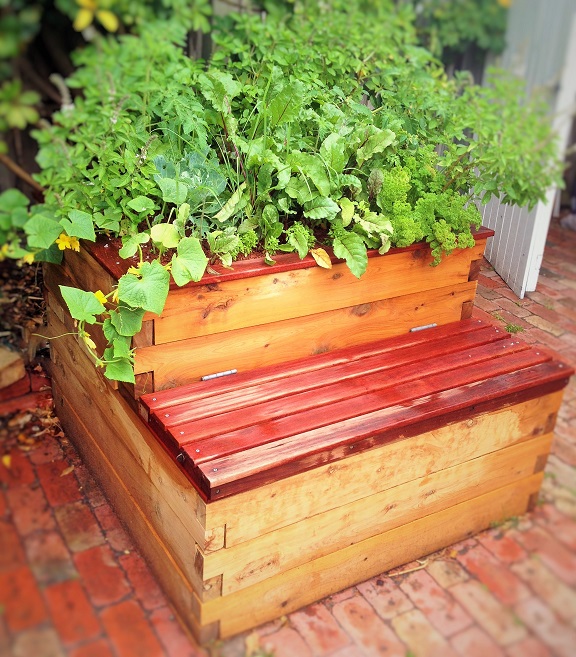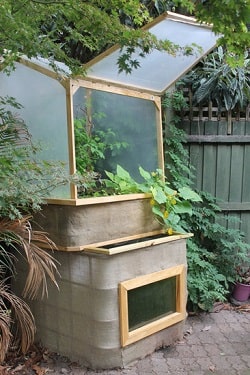When I started aquaponics, the aquaponics aesthetic was not a priority. I was very focused by the technicality of the system. My aim was to keep the fish alive and grow plants.
I started to put things together and as I reached my goal, I wanted to have more setups running.
Only thing, my partner was not really onboard…
Yes she was super happy to eat fresh fish and vegetables but not so happy to see plastic tanks in the backyard! Ooooopssss…
You see, when we focus on the technical side, we sometimes forget the appearance of the whole setup. No worries, I quickly got my partner back onboard. I did so by applying some simple principles that you too can use!

4 Principles of an aesthetic aquaponics system:
1. Avoid visible pipes
Pipes are necessary in the design of your aquaponics setup. However, they don’t look the best. The idea is to hide them or cover them with natural materials.
2. Avoid visible plastic/PVC/liner…
Plastic is a quick and easy way to get aquaponics tanks. However, plastic doesn’t look very nice in a backyard. If you really want to work with plastic tanks, make sure to cover them. Wood is an excellent option.
3. Avoid visible screw/bolt
A few well aligned screws can be acceptable on an aquaponics system. But too many of them will give an heavy look to the system. It quickly gives a messy appearance to the whole system. There are some ways to completely avoid screws. Less screws is the secret to a pure and light design.
4. Use natural materials
As we saw above, artificial materials such as plastic don’t present well in a backyard. Expecially if we try to recreate a natural ecosystem. On the opposite, natural materials such as wood and stone are very well received by human eye. I know it may not always seem easy to build an aquaponics system with those materials. But you can always use those to cover the articifcial ellements.
Wood
If you have a plastic tank, building a wooden box around it can be a cheap and incredibly efficient solution.
Hessian
Hessian fabric is a very interesting material to use for an easy aquaponics relook. If you want to cover ugly parts without spending too much money, hessian is perfect. See how I relooked a basic IBC aquaponics system into something nice:

Positive side effects of covering your tank
UV protection
A side benefit of covering your plastic/PVC tanks is that it will protect them from UV exposition. This protection has 2 effects. First it modifies the risk of toxic leaking. Indeed, when heated, some plastics can release toxic particles into the water. By covering the tanks, we reduce this risk.
Secondly, It impacts the equipment lifetime. Plastic material exposed to UV can become porous or break. By protecting the tanks from UVs, we increase the equipment lifetime.
Temperature stability
An off-ground tank offers a large surface of contact with the air. The fin plastic walls allow the temperature of the air to modify the water temperature. Hence, we observe high temperature variation even between the day and night.
In aquaponics we prefer to keep a constant water temperature. It is better for all living creatures. In Summer we prefer to reduce the maximum temperature. Fish such as trout could hardly survive a temperature above 22C. In winter it is better to maintain the minimum temperature as high as possible. Some native fish wouldn’t handle low temperature too well. Applying multi-layers around an off-ground system limits the heat exchanges. For a better result you can even add a polystyren layer between the plastic tank and the wood/essian layer.
Algae
Algae are often present in fish ponds. The nutrients present in the aquaponics system are perfect for them. All they need to grow is light. An off-ground fish tank with fin plastic walls will allow the light to go through. Hence, the algae development will increase. Covering the fish tank with a layer of wood or hessian will decrease the algae development. Most people think algae are a problem as they are in competition with plants for nutrients. In fact, aquaponics systems often generate more nutrients than the plants can absorb. However, algae have an other impact. An impact on oxygen! Most people think algae are great since they produce oxygen thanks to photosynthesis. But people too often forget that algae don’t produce oxygen during the night but consume it! hence, the morning is most critical time as the oxygen is at his lowest point. Applying a layer of wood or hessian fabric around your tank will allow you to reduce the critical oxygen concentration in the morning.
Aquaponics aesthetic is now a priority
As you may know, today I highly focus on the style of my aquaponics systems. All my off-ground aquaponics systems are built in cypress wood. I choose this material because it is both strong and aesthetic. Yes, the design takes a bit more time than a simple plastic aquaponics. But the positive impact on the backyard worth it. Not only the setup is efficient, but it is also a feature by itself. I even changed the name of my website to “Aquaponics Revolution”. My aim is to go beyond conventional aquaponics. I now offer a new holistic aquaponics experience. it includes aesthetic, food production, water feature, outdoor furniture and much more.
Plastic is still around!
Few months ago I showed you how to build a swirl filter. I made it from a drum tank bought at the local handy shop. This swirl filter is working perfectly. It captures quantity of solids and limit my nitrogen level to increase too quickly. It also allows me to limit the frequency of my grow-bed cleaning. I even made a step by step guide to build this same filter. You can have a free access from the free training link.
Anyway, when I built this swirl filter, I wanted to quickly have something efficient. Indeed, I thought I would fix the aesthetic in a second step. Like most short term things, it always last longer than expected. Every time I saw this filter, I was ashamed by the poor plastic look. I finally found the time to work on it. I wrapped some hessian fabric around it and glued it. The filter is now almost invisible, I feel much better! This technique can be used on a lot of systems. You can now transform an ugly aquaponics system into good looking aquaponics. Let me know what is the general look of your aquaponics setup in the comments. Will you apply these tricks to your aquaponics system and make it more aesthetic?
You will probably be interested to discover my six steps to build and manage an Aquaponics system. Click here to access for free! Thanks and good reading 🙂

